The Evolution of Coca-Cola Logo: A Journey through Time
For over a century, Coca-Cola has been a globally recognised brand that is integral to the soft drink industry.
Founded by John Stith Pemberton in 1886, Coca-Cola quickly became one of the world's most popular soft drinks. Today, we can find the iconic red and white labels on bottles and cans in almost every supermarket, grocery shop, and vending machine worldwide.
What makes Coca-Cola so fascinating is its long-standing reputation and cultural significance. The brand's distinctive logo and cursive script have become synonymous with happiness, refreshment, and America.
From the beginning, Coca-Cola has captured the imagination of consumers, inspired countless imitations, and spawned a global industry worth billions of dollars.
Despite its popularity, Coca-Cola's recipe has remained a closely guarded secret. Only a few people are privy to the exact ingredients and ratios used in its production, making it one of the most intriguing food and beverage industry secrets.
The company has gone to great lengths to protect its trade secrets, even going so far as to keep the original recipe in a vault at its headquarters in Atlanta, Georgia.
Over the years, numerous attempts have been made to decipher Coca-Cola's secret recipe, with some claiming to have found the original recipe. However, the company has consistently denied these claims and kept its recipe secret.
Despite this secrecy, Coca-Cola's influence on global culture is undeniable. From its iconic logo to its ubiquitous presence in popular culture, the brand has become an enduring symbol of American ingenuity and innovation.
Today, more than a century after its founding, Coca-Cola holds a special place in the hearts and minds of people worldwide.
- Coca-Cola, founded in 1886, quickly became an iconic global brand synonymous with refreshment.
- The logo has evolved significantly, transitioning from basic block letters to the refined Spencerian script.
- The introduction of the red border and colour in the late 19th century solidified brand recognition.
- Coca-Cola's logo serves as a cultural icon, representing Americana and resonating across generations.
- Recent controversies highlight the brand's ongoing relevance and its blend of tradition with modern technology.
Original Coca-Cola Logo: 1886 – 1887

The Coca-Cola logo has a rich and fascinating history stretching over a century. Several minor and significant changes have occurred in its development, but each step has played a crucial role in creating the iconic design we know today.
The earliest version of the Coca-Cola logo was far from the instantly recognisable emblem we see today. It was pretty simple in comparison. The original logo featured a simple black-and-white design with block letters and serifs.
Although it may seem unimpressive by today's standards, this design was groundbreaking, laying the foundation for the logo's evolution.
The Famous Coca-Cola Script: 1887 – 1890
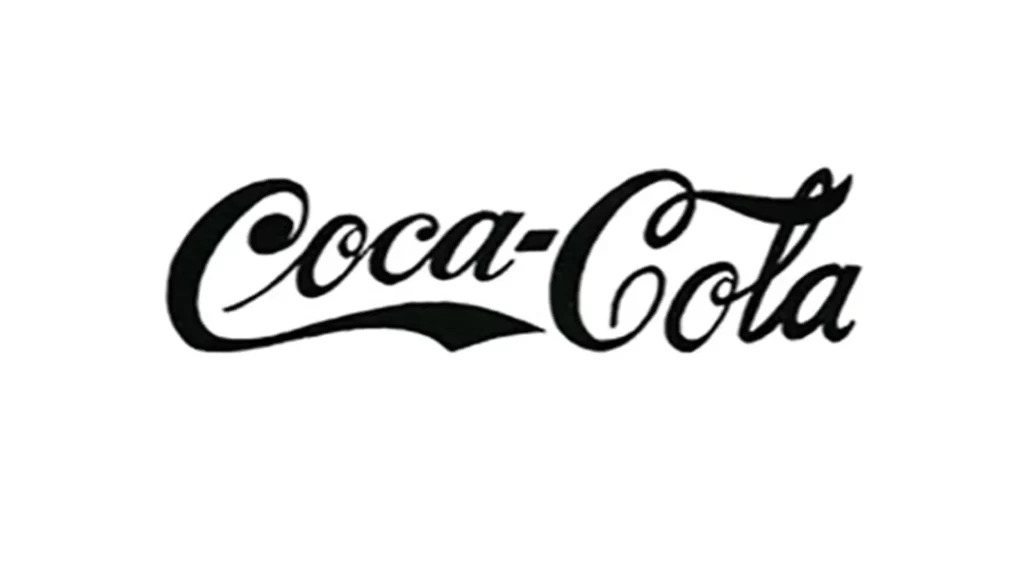
In the early days of the Coca-Cola brand, the logo was a simple black-and-white design with block letters and serifs.
However, as the brand's popularity grew, its founder, John S. Pemberton, recognised the need for a more distinctive and sophisticated wordmark. This led to the introduction of the iconic “Spencerian” typeface in 1890.
With its flowing lines and graceful curves, the Spencerian typeface was a marked departure from the original design. It was designed by an accountant named Frank Mason Robinson, who was also responsible for naming the brand.
The typeface was inspired by the ornamental handwriting of the Spencerian style, which was very popular in the United States at the end of the 19th century. This new typeface immediately set Coca-Cola apart from its competitors and gave the brand its own visual identity.
The Spencerian script was a handwriting style developed in the mid-19th century, characterised by graceful, flowing lines and detailed curves. It gained immense popularity among business professionals and educational institutions in the United States.
Selecting the Spencerian script for Coca-Cola's logo imbued the brand with an aura of sophistication and grace, matching the aspirational ideals and premium quality the company sought to convey at the time.
Redesign: 1889 – 1892

In 1889, Coca-Cola's logo underwent a significant overhaul that laid the foundation for the brand's iconic identity. The new design featured a more refined and elegant version of the brand's wordmark, with elongated lines on both “Cs” that were even more curved than before.
Two small diamond-shaped lozenges were also added, drawn in black in the centre of the negative space of the letter. The lozenges added visual interest and balance to the design while emphasising the brand's commitment to quality.
One of the most striking features of the new design was the bold, enlarged comma character that followed the lettering. This punctuation mark conveyed a sense of urgency and excitement around the brand, encouraging consumers to try the product.
The comma also helped to break up the text and create a sense of flow and rhythm within the design.
The 1889 redesign marked a turning point for the Coca-Cola brand, as it helped establish its visual identity and set the stage for future iterations of the logo.
Short-lived: 1890 – 1891
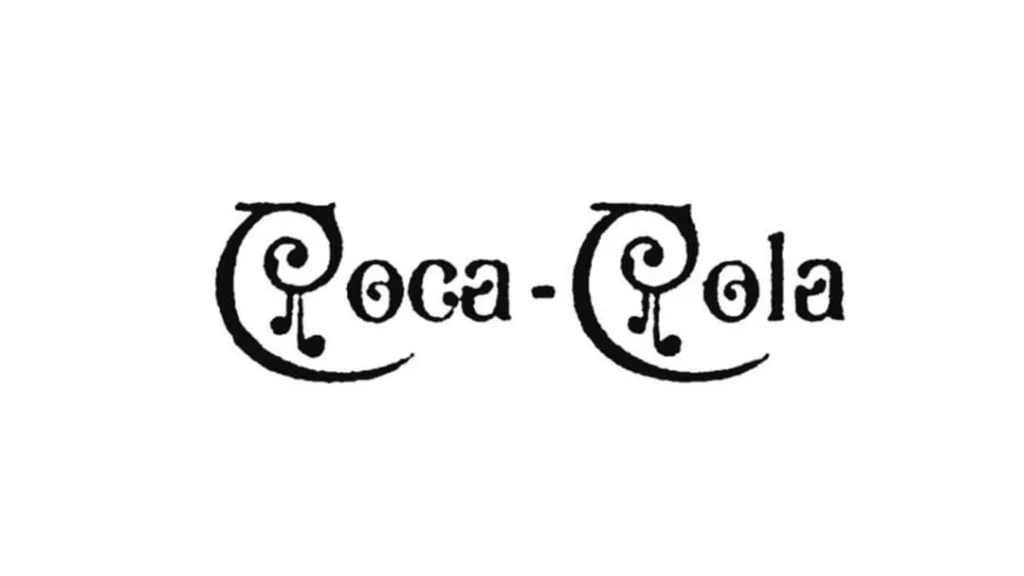
This version of the logo was a marked departure from the original design, which consisted of block letters with serifs. The new lettering was much more ornate, with sweeping curves and intricate details that gave the logo a sense of elegance and sophistication.
The decorative swirls added a touch of whimsy to the design while underlining the brand's commitment to quality and attention to detail.
Despite the initial excitement surrounding the new design, it was short-lived. The 1890 version of the Coca-Cola logo was discontinued just a year later as the brand opted for a more straightforward, sleeker design.
The legacy of this version of the logo lives on, however, as it represents a significant moment in the evolution of the Coca-Cola brand.
Going Red: 1891 – 1899

The most significant change to the logo was the addition of a red rectangular border around the wordmark.
This border helped to create a sense of cohesion and unity within the design while also making the logo stand out on promotional materials and product packaging.
The frame also helped to build brand recognition as consumers associated the red border with the Coca-Cola brand.
Another change to the logo was the introduction of the colour red. While the original logo was black and white, the 1890 version featured a bright, bold shade of red that would become synonymous with the Coca-Cola brand.
The use of red helped create a sense of energy and excitement around the brand while also emphasising the brand's commitment to quality and attention to detail.
The red and white colour scheme of Coca-Cola has contributed significantly to its brand identity. Red has long been associated with excitement and energy, while white conveys purity.
Together, these colours communicate an inviting and warm message to consumers. By consistently using this palette, Coca-Cola has remained an instantly recognisable brand, cementing its presence on store shelves and in consumers' minds.
Despite the minor changes to the logo, the essence of the Coca-Cola brand remained intact. The iconic wordmark remained central to the design with its elegant lettering and flowing lines.
At the same time, adding the red frame and colour helped create a sense of consistency and brand recognition. Over the years, the Coca-Cola logo evolved, but the 1890 version represented a crucial moment in the brand's history.
Refinement: 1899 – 1934
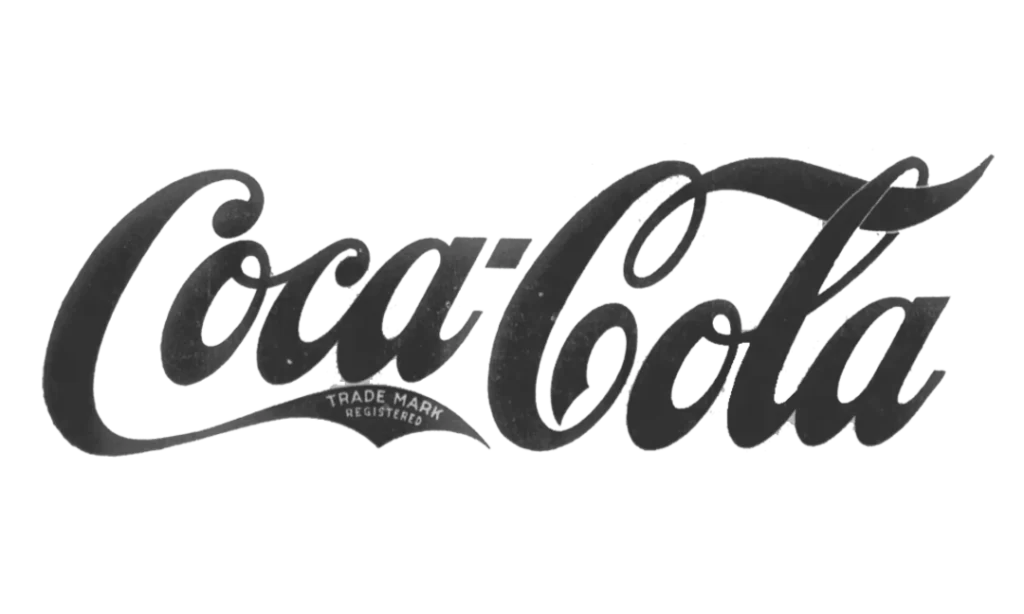
The 1899 version of the Coca-Cola logo is very similar to today's version, with only minor differences in the letters' contours and the lines' thickness. The design concept remained unchanged, with the characteristic font and flowing lines that had become synonymous with the Coca-Cola brand.
Despite the subtle changes, this version of the logo represented a significant step in the evolution of the Coca-Cola brand.
The narrower and taller contours of the letters gave the logo a more elegant and refined look. At the same time, the bolder lines helped to make the wordmark stand out on promotional materials and product packaging.
Redesign: 1934 – 1941
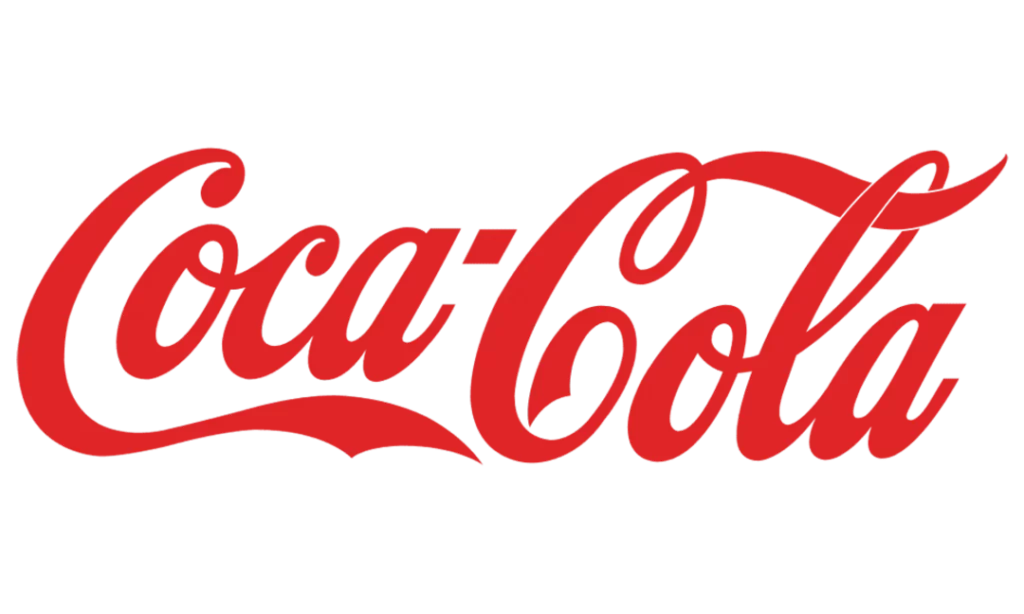
One of the most significant moments in the history of the Coca-Cola logo was in 1934, when the brand underwent a significant redesign. This redesign introduced the iconic red colour, which became synonymous with the Coca-Cola brand and remains a hallmark of the company today.
While the wordmark remained unchanged, introducing red was a bold and decisive move that would forever change the brand's path. The bold and bright shade of red immediately caught the eye and grabbed attention, giving the brand a sense of energy and excitement.
The use of red also helped to emphasise the brand's commitment to quality and attention to detail. The colour is often associated with passion, power and strength, making it a fitting choice for a brand that has become a global symbol of joy and refreshment.
The redesign of the Coca-Cola logo in 1934 was a masterstroke and helped the brand gain new recognition and popularity. The iconic red colour, with the elegant font and flowing lines, created a sense of timelessness and classic sophistication, making the Coca-Cola logo an enduring symbol of American culture and identity.
The Coca-Cola Logo We Know: 1941 – Today
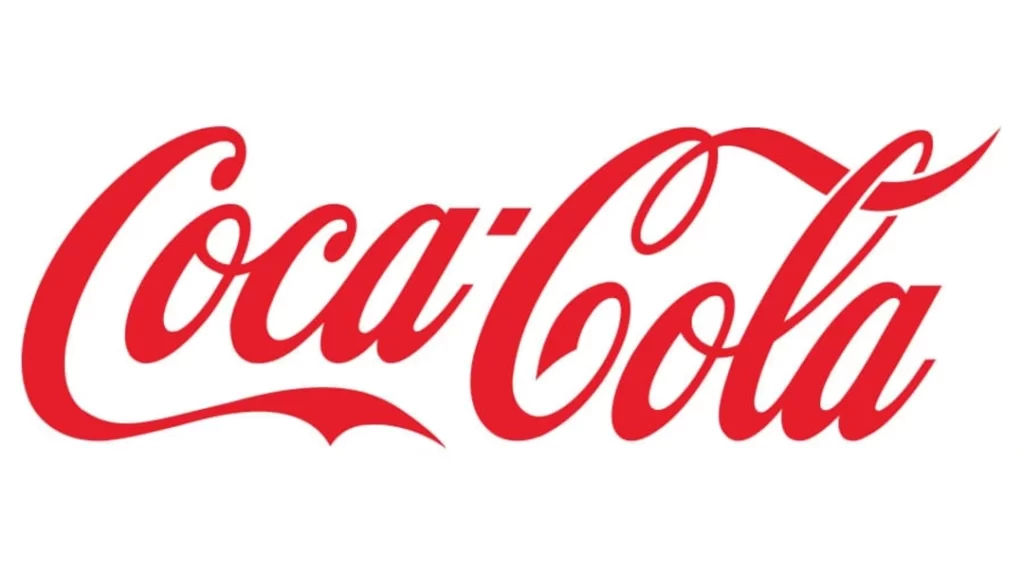
One of the most striking changes in the history of the Coca-Cola logo took place in 1941 when the design team made some significant changes to the wordmark. This redesign departed from earlier versions' more traditional and conservative approach and moved towards a more modern and dynamic look.
The most noticeable change in the 1941 redesign was the introduction of an italic font. This change gave the logo a sense of forward movement and added energy and excitement that had not been present in earlier versions.
Using an italic font also gave the wordmark a more modern look, keeping with the changing times and trends of the 1940s.
Another necessary change was removing the frame that had previously surrounded the wordmark. This made the letters stand out better and gave the logo a slimmer and more modern look.
By eliminating the frame, the designers could draw more attention to the elegant typeface and flowing lines that had become Coca-Cola's trademark.
Finally, the letters were elongated, giving the wordmark a slimmer and more refined look. This change helped create a sense of elegance and sophistication, keeping with the brand's image as a premium quality product.
Coca-Cola's Global Cultural Impact
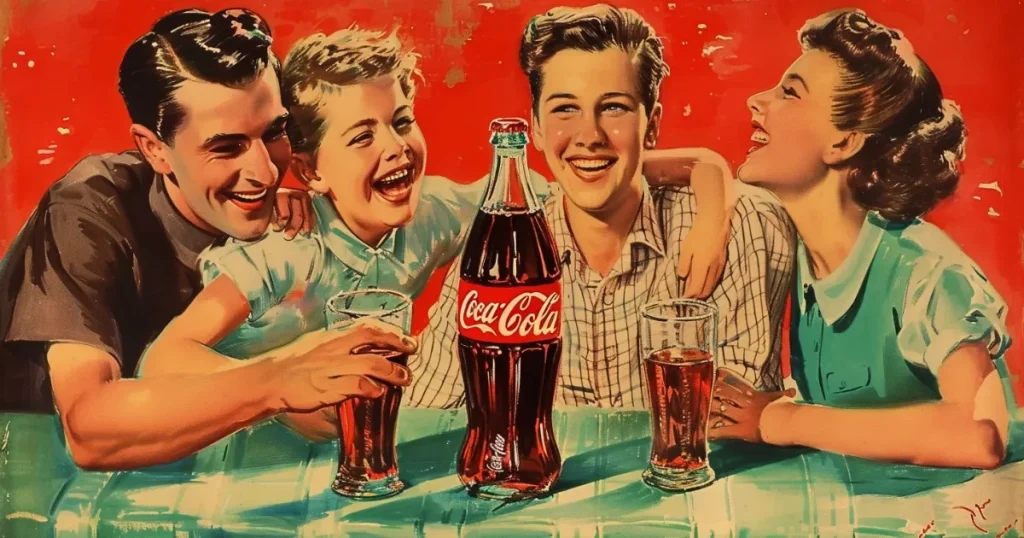
Coca-Cola has become a household name and a cultural icon worldwide. Its strategic advertising campaigns have enabled it to resonate with various cultures by catering to local tastes and traditions without losing its core identity.
From sponsoring the Olympic Games to its holiday-themed campaigns, Coca-Cola has used events with global appeal to embed its message of togetherness and joy across different markets. This strategy ensured its place as a universal symbol of refreshment and happiness.
The Role of Coca-Cola in Marketing Innovation
Coca-Cola has been at the forefront of marketing innovation. One of its pioneering strategies involved creating a bespoke glass bottle, uniquely contoured in 1915, to stand out from competitors.
The bottle became as iconic as the drink itself. Coca-Cola's advertising campaigns have also been groundbreaking, featuring lively visuals and catchy jingles that resonated across generations. Its continuous commitment to innovative marketing has kept the brand fresh and relevant over the decades.
The Coca-Cola Logo as a Cultural Icon
The Coca-Cola logo transcends corporate branding, having entrenched itself in cultural history as an emblem of Americana. Its presence in art, music, and political discourse highlights its ubiquity.
Andy Warhol's art famously captured its iconicity, while the brand's consistent appearance in films and music has also made it a symbol of nostalgia and modernity. In this way, the logo has firmly established itself beyond commercial confines, becoming a global cultural touchstone.
Coca-Cola's Recent Marketing Campaigns and Controversies
In November 2024, Coca-Cola ventured into artificial intelligence by releasing three AI-generated videos for its Christmas campaigns, reviving the nostalgic 1995 “Holidays are Coming” ads.
Crafted by AI studios Secret Level, Silverside AI, and the Wild Card, these ads were designed to merge past and present marketing strategies using advanced technology.
However, the AI-driven creativity sparked significant backlash on social media platforms. Alex Hirsch, known for creating Gravity Falls, publicly criticised the approach, suggesting a disregard for artists in favour of artificial methods.
Coca-Cola responded by asserting its commitment to blending human creativity with technological innovation, defending the integrity and intention of its campaigns.
Coca-Cola's operations have not been without wider socio-political challenges. The brand has recently been enveloped in criticism from the pro-Palestine movement, where a boycott emerged due to perceived political alignments and donations, particularly to the Israeli organisation Im Tirtzu.
This controversy intensified during the Gaza war, leading to Coca-Cola's Bangladesh distributor releasing an advertising campaign in June 2024 to mitigate these tensions and reposition its public image in regions with heightened boycott activity.
Wrapping Up
In summary, the Coca-Cola logo's journey through time has been fascinating.
From the first designs with simple serif fonts to the iconic script logo we know today, the design has undergone many changes without losing its unique identity.
Each redesign reflected the cultural and artistic trends of the time while remaining true to the brand's core values.
The Coca-Cola logo has evolved into more than just a brand identity. It has become a symbol of nostalgia, tradition and a bygone era. Its design has inspired countless imitations, and we cannot underestimate its influence on popular culture.
The evolution of the Coca-Cola logo is a testament to the enduring power of great design and branding, and it's a journey we'll be following for many years to come.

